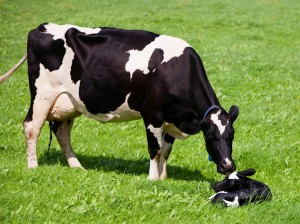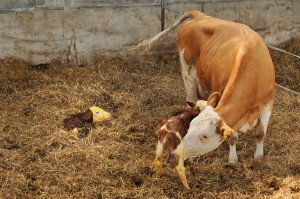Cattle Diseases
Retained Placenta in Cattle
Most cows will pass the afterbirth (placenta, cleansing or calf bed) within 6 hours of calving. Some cows take up to 24 hours. If the placenta is retained longer than this, the condition is classified as retained placenta or retained foetal membranes (RFM). The condition is more common in dairy than beef suckler herds and incidence and prevalence of the condition varies markedly. There is limited information on disease incidence in organic herds, although Danish organic dairy herds reported fewer treatments for RFM than conventional herds (Bennedsgaard et al., 2003). Blowey (1999) suggests that an incidence rate above 10% (10 cases per 100 cows) in a calving season should cause concern. It is, however, well recognised that the effects of retained afterbirth on individual cows vary from severe symptoms of fever and illness, such as ketosis, to no clinical signs at all, and the target levels in each herd have to be adjusted according to the significance of the condition within the herd. Longer term effects of RFM are an increase in time to first service, lower first service conception rate and thus an increase in time to conception (Fourichon et al., 2000; McDougall, 2001). Cows that abort, calve prematurely, have twins, have a difficult calving or any other debilitating illness during calving are more likely to cleanse poorly than full term, uncomplicated calvings. Unhygienic calving conditions are an obvious risk for both retained placenta and metritis. A variety of nutritional risk factors are associated with RFM (Roche, 2006). Overfat cows and vitamin E/selenium deficiencies have also been associated with increased incidence of retained afterbirth, although micronutrient imbalances are unlikely to be the most important cause of RFM (Mee, 2004). Cows that have an induced calving are more at risk of RFM (McDougall, 2001a).
Controlling and Preventing Retained Placenta
The control of retained placenta needs to focus on the control of causative factors like abortions, premature calving, calving difficulties, and vitamin and mineral deficiencies. Milk fever, even in its subclinical form needs to be controlled. Milk fever and even sub-clinical calcium deficiency can be associated with an increased risk of RFM (Zhang et al., 2002; Melendez et al., 2004) with older cows more at risk of lower blood calcium. Good control of feeding and condition during the dry period and avoiding cows becoming overfat, will also reduce the incidence of retained afterbirth.
In recent literature reviews, both Selenium deficiency and reduced serum concentrations of Ca, Mg, Mo and Zn were all associated with a high incidence of RFM (Allison and Laven, 2000, Bourne et al., 2007, Bicalho et al., 2014). In both instances, supplementation with the respective deficient mineral can help reduce retention.
Although these vitamins and minerals can be supplemented, correct pasture based diet formulation could prevent the need for additional supplementation. For example, Beeckman et al., (2010) showed that grass clover silage and mixed silage were shown to have significantly more vitamin E than hay, maize or grain. However, in the study by Bourne et al. (2007), the synthetic form of vitamin E (alpha-tocopherol acetate) was found to be more effective than the natural form of vitamin E (alpha-tocopherol).
Treating Retained Placenta
A veterinary surgeon should preferably be called to any cow with RFM that shows clinical signs of fever, depression or reduction in milk yield as these cases may have secondary problems or require antimicrobial therapy. If the cow shows no signs of ill health, treatment can be left until four to five days after calving.
Many commonly used treatments have no proven efficacy. In a review on the subject manual, removal has been shown to be detrimental on subsequent fertility and intra-uterine antibiotics have been ineffective. Systemic antibiotics are only indicated if the cow has a fever, they have not shown to prevent metritis when used routinely in cows with uncomplicated retained foetal membranes. Prostaglandins and oxytocin were both ineffective in treating the condition (Beagley et al. 2010).
In the longer term, cows with RFM treated with antimicrobials have not been shown to have any difference in final chance of becoming pregnant, although the number of days open in antimicrobial treated cows is reduced (Goshen and Spigel, 2006). A small study comparing use of intra-uterine antimicrobial pessaries with intra-uterine iodide pessaries found no difference in subsequent clinical signs of endometritis or subsequent fertility parameters (Brooks, 2001). The author suggests that iodide pessaries may be of use as a non-antimicrobial approach to RFM therapy. Therefore, as part of a rational approach to therapy in post partum cows (Frazer, 2005), all cows should be closely monitored (taking rectal temperatures and monitoring changes in appearance and behaviour) for the first 10-14 days post partum as they are at higher risk of developing infection and becoming pyrexic (temperature >39.5ºC) and if so, should be treated with systemic antimicrobials. Cows treated with antimicrobials later in lactation, at 2-3 weeks post partum, after placental shedding may benefit by means of reduced duration of infection, improved reproductive performance and thus reduced culling (Konigsson et al., 2001; McDougall, 2001b; Scott et al., 2005), although this in effect would be treating cows with endometritis at this stage, not RFM per se. Glanville and Dobson (1991) showed that there was no benefit in a routine injection of prostaglandin on dairy cows with retained placenta in the period 14 to 28 days after calving when re-breeding commenced more than 70 days after calving.
Retained Placenta and Welfare
There are no particular welfare issues associated with the condition, although any cow which is sick should be attended by a veterinary surgeon. An excessive incidence of RFM (i.e. >10% of cows with RFM) should be addressed as this may be indicative of suboptimal health and welfare, particularly with regard to calving cow management and nutrition.
Good Practice Based on Current Knowledge
All of the following points should be included in the farm’s herd health plan:
- Record carefully all the calvings resulting to retained placenta, noting details about the cow’s other symptoms or problems
- Assess the situation after each calving season and decide whether there is a need for improvement (less than 10% of the calvings should result in retained placenta)
- Avoid over-fat cows at calving (condition score 2.5-3 at drying off and at calving)
- Control milk fever. If older cows have a history of previous milk fever, consider giving supplementary calcium at calving to avoid sub-clinical hypocalcaemia or adjust the feeding pre-calving
- Avoid vitamin E/selenium deficiency in your herd
- Maintain good calving box and calving assistance hygiene


 American English
American English



Comments are closed.